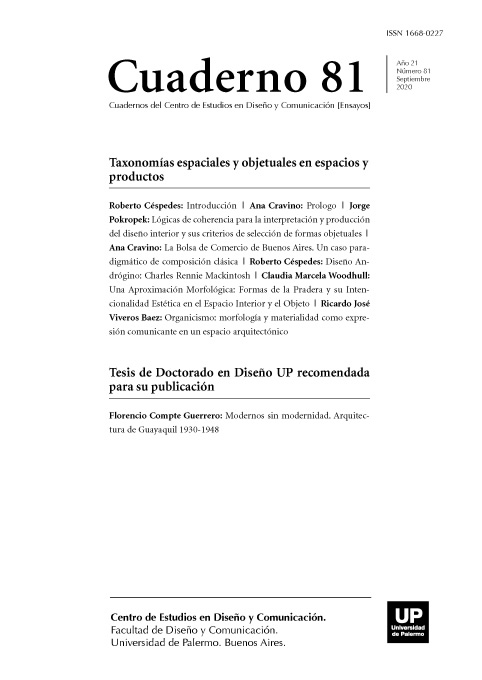Organicismo: morfología y materialidad como expresión comunicante en un espacio arquitectónico
Abstract
From the organic architecture, understood as a philosophy that promotes the harmony between the human habitat and the natural environment, marks a substantial break with the traditional formal compositions, and from where the properties were taken of new materials and new productive techniques. This movement arises in opposition rationalism or functionalism, manifesting itself in the first decades of the 20th century and with this the design of objects is compromised and particularly the furniture design of interiors, based on organic structures, and a form of design that opens borders between the material and the sentimental, whose source of experiences is nature. The great diversity of solutions –present in our natural environment– to structural problems, in terms of energy and functionality, they have already been tested for millions of years, and in it we can find all kinds of patterns and combinations of shapes, colors and textures that are the foundation of organic design as a source inexhaustible inspiration for designers. It is constituted as a powerful tool and endless source of inspiration, united by the principles of life itself, trying to imitate the forms, textures or functions of living organisms to reach solutions of optimal design.
In the present work a brief tour through the beginnings of organic design is shown, particularly furniture design, going through some representative classics of the Nordic and American design, from the form-matter relationship.
Then one of the main exponents of organic design is recognized: Alvar Aalto, Finnish architect and designer, through two of his most iconic creations; the project Sanatorio de Paimio and the chair 41. The central idea of the Sanatorium was a building that favored the healing and rehabilitation of tuberculosis patients. East The project was conceived integrally, which led to the definition of a specific furniture. Product of it is chair number 41, later known as chair Paimio de which realizes its morphological and material characteristics. Finally I know establishes a relationship where the object connects visually and functionally with the context of its interior location of the architectural ensemble
References
Araya,V.; Alfaro, M. & Andonegui, M. (2007). Constructivismo; orígenes y perspectivas. Laurus, 13(24), 76-92.
ARQHYS. (2012). Sanatorio Paimio de Alvar Aalto. Revista ARQHYS.com. Obtenido de http://www.arqhys.com/sanatorio-paimio-de-alvar-aalto.html.
Eco, U. (2013). La estructura ausente. Buenos Aires: Edit. De bolsillo.
Jové Sandoval, J. (2003). Alvar Aalto; proyectando con la naturaleza. Valladolid; Universidad de Valladolid.
Lévy, P. (1999). ¿Qué es lo virtial? Barcelona: Paidos.
Lago García, C. (2007). Antropología filosófica; el ser humano como problema filosófico. Centro de Integración Tecnológica para el Aprendizaje (CITA). Escuela de Artes Plásticas de Puerto Rico. Obtenido de: http://cita.eap.edu/moodle/pluginfile.php/1831/mod_resource/content/1/Filosofia/Antropologia_Filosofica.pdf
Peña, W. (2012). La virtualidad como lugar para la reflexión. Reflexiones teológicas 8 (119 - 130). Bogotá, Colombia.
Pokropek, J. & Amoroso, J. (S/F). Revisando nuestra morfología arquitectónica en función del mensaje estético. Obtenido de: http://wiki.fadu.uba.ar/images/d/d8/Revisando_“nuestra”_morfolog%C3%ADa_arquitectónica_en_función_del_mensaje_estético._Desde_la_“Teor%C3%ADa_del_habitar”_a_“Las_expresiones_de_la_Arquitectura”.pdf
Pokropek, J. & Cravino, A. (2018). Algunas precisiones sobre la borrosa noción de “Materia” para el diseño interior. Cuaderno 70. Centro de Estudios en Diseño y Comunicación. pp. 15-27.
Rios, S. (2014). Convivencias entre el arte y el diseño; el resurgir del diseño en la década de los cincuenta y su expansión hacia la cultura de lo cotidiano. Tsantsa. Revista de Investigaciones Artísticas Núm. 1- (Año, 2014) ISSN: 1390-8448).
Ruiz Trujillo, P. (2015). Aristóteles, De la potencia al acto. Bonalletra Alcompas, S. L. Sanatorio Antituberculoso Paimio. Obtenido de: https://es.wikiarquitectura.com/edificio/sanatorio-antituberculoso-paimio/
Schildt, G. (1996). Alvar Aalto; obra completa: arquitectura, arte y diseño. Barcelona: Gustavo Gili, S. A. Organic Design, Products Inspirated by Nature (2016). Send Point Publishing Co., Ltd.
Designaholic (2017). La importancia de la silla serie 7. Obtenido de: http://designaholic.mx/2017/09/iho-espacios-presenta-la-importancia-la-silla-serie-7-la-historia-deldiseno.html Olguin, G.; Castellano, L.; Abraham, M.; Bourdichon, M.; De La Fuente, F.; Giurdanella,
S.; Hernández, T.; Scocco, M. (2009). Leer la Forma; estudio sobre la morfología aplicada al diseño . 1ra. Edición. Buenos Aires: Redargenta Ediciones.
Los autores/as que publiquen en esta revista ceden los derechos de autor y de publicación a "Cuadernos del Centro de Estudios de Diseño y Comunicación", Aceptando el registro de su trabajo bajo una licencia de atribución de Creative Commons, que permite a terceros utilizar lo publicado siempre que de el crédito pertinente a los autores y a esta revista.


